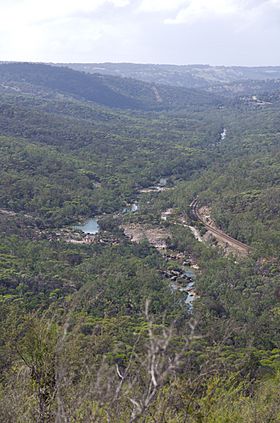Avon River (Western Australia) facts for kids
Quick facts for kids Avon |
|
|---|---|

Avon River flowing through the Avon Valley National Park
|
|

Location of the Avon River and its catchment area
|
|
| Country | Australia |
| State | Western Australia |
| Region | Wheatbelt |
| Physical characteristics | |
| Main source | surface runoff East of Pingelly 269 m (883 ft) 32°44′52″S 117°28′0″E / 32.74778°S 117.46667°E |
| River mouth | confluence with Wooroloo Brook to form the Swan River below Mount Mambup 29 m (95 ft) 31°44′34″S 116°4′4″E / 31.74278°S 116.06778°E |
| Length | 240 km (150 mi) |
| Basin features | |
| River system | Swan River |
| Basin size | 125,000 km2 (48,000 sq mi) |
| Tributaries |
|
| National park | Avon Valley National Park |
The Avon River is an important river in Western Australia. It is a major branch, called a tributary, of the Swan River. The Avon River flows for about 240 kilometres (150 mi) from where it starts to where it joins the Swan River. Its catchment area, which is the land where all the rain collects and flows into the river, covers a huge 125,000 square kilometres (48,000 sq mi).
Contents
The Avon River's Journey
The Avon River begins near Pingelly. Its journey starts from surface runoff, which is water that flows over the land after rain. The river then flows through the beautiful Avon Valley National Park.
Where the River Flows
The Avon River's catchment area covers a large part of the Wheatbelt region in Western Australia. This area is mostly dry. Water usually only flows into the river from the western edge of the basin.
The river has three main smaller river systems that feed into it. These are the Mortlock River, the Yilgarn River, and the Lockhart River.
The Avon River flows past a place called County Peak. This creates a very scenic view from the top of the peak.
River Features and Activities
Many smaller creeks and rivers join the Avon River. About thirty of them flow into it. Some of the bigger ones include the Dale River, Brockman River, Mortlock River, and the Mackie River. Most of these rivers are ephemeral. This means they only flow after it rains, usually in winter and spring.
There are also some parts of the river that always have water. These are called permanent pools. Examples include Burlong Pool, Robins Pool, Long Pool, Cobblers Pool, and Jimperding Pool.
The Eastern Railway line also follows the Avon River Valley. This railway was built in the 1960s.
The Avon River is famous for an exciting annual event called the Avon Descent. This is a whitewater boating race.
River Environment and Soils
The land around the Avon River has very old soils. This is because it sits on a very ancient part of the Earth's crust called the Yilgarn Craton. Because the soils are so old, the plants that grow there have very deep roots.
The old soils also mean that the river water can be quite salty. After land was cleared for farming, the salt in the soil started to move into the rivers. This makes the water saltier than what is considered "fresh" water.
People are working to fix these soil salinity problems. There are special programs and groups that help manage the land around the river. They work to reduce the saltiness and protect the farming areas. These groups get support from businesses and other organizations.
See Also
- Avon Valley National Park
- Avon Descent

